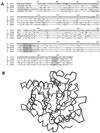Onchocerca volvulus glycolytic enzyme fructose-1,6-bisphosphate aldolase as a target for a protective immune response in humans
- PMID: 11796620
- PMCID: PMC127653
- DOI: 10.1128/IAI.70.2.851-858.2002
Onchocerca volvulus glycolytic enzyme fructose-1,6-bisphosphate aldolase as a target for a protective immune response in humans
Abstract
To identify potential vaccine candidates for the prevention of infection with the filarial nematode Onchocerca volvulus, we screened an O. volvulus L3 stage cDNA library with sera from putatively immune (PI) subjects, and a prominent immunogenic clone of 1,184 nucleotides was identified. It contained an open reading frame of 363 amino acids encoding the glycolytic enzyme fructose 1,6 bisphosphate aldolase (Ov-fba-1). Immunolocalization experiments demonstrated that the protein was most abundantly expressed in metabolically active tissues, including body wall muscle and the reproductive tract of adult female worms. Immunoelectron microscopy of L3 demonstrated binding in the region where the cuticle separates during molting, in the channels connecting the esophagus to the cuticle, and in the basal lamina surrounding the esophagus and the body cavity. Among subjects from areas where this organism is endemic specific humoral and cellular immune responses to recombinant protein were observed in both PI and infected subjects, whereas responses were not observed among subjects who had not been exposed to O. volvulus. Despite the absence of differential responsiveness in parasite-exposed human populations, when the recombinant was tested for protective efficacy in a mouse chamber model, a reduction in survival of larvae by ca. 50% was seen. This observation provides support for the further study of this parasite enzyme as a vaccine candidate in larger animal models.
Figures






References
-
- Abraham, D., A. M. Lange, W. Yutanawiboonchai, M. Trpis, J. W. Dickerson, B. Swenson, and M. L. Eberhard. 1993. Survival and development of larval Onchocerca volvulus in diffusion chambers implanted in primate and rodent hosts. J. Parasitol. 79:571–582. - PubMed
-
- Brown, C., B. H. Toh, J. S. Pedersen, F. M. Clarke, I. R. Mackay, and I. Gust. 1987. Autoantibody to aldolase in acute and chronic hepatitis. Pathology 19:347–350. - PubMed
-
- Cooper, P. J., I. Espinel, W. Paredes, R. H. Guderian, and T. B. Nutman. 1998. Impaired tetanus-specific cellular and humoral responses following tetanus vaccination in human onchocerciasis: a possible role for interleukin-10. J. Infect. Dis. 178:1133–1138. - PubMed
-
- Doenhoff, M. J. 1998. A vaccine for schistosomiasis: alternative approaches. Parasitol. Today 14:105–109. - PubMed
Publication types
MeSH terms
Substances
Associated data
- Actions
Grants and funding
LinkOut - more resources
Full Text Sources
Other Literature Sources
Research Materials
Miscellaneous

